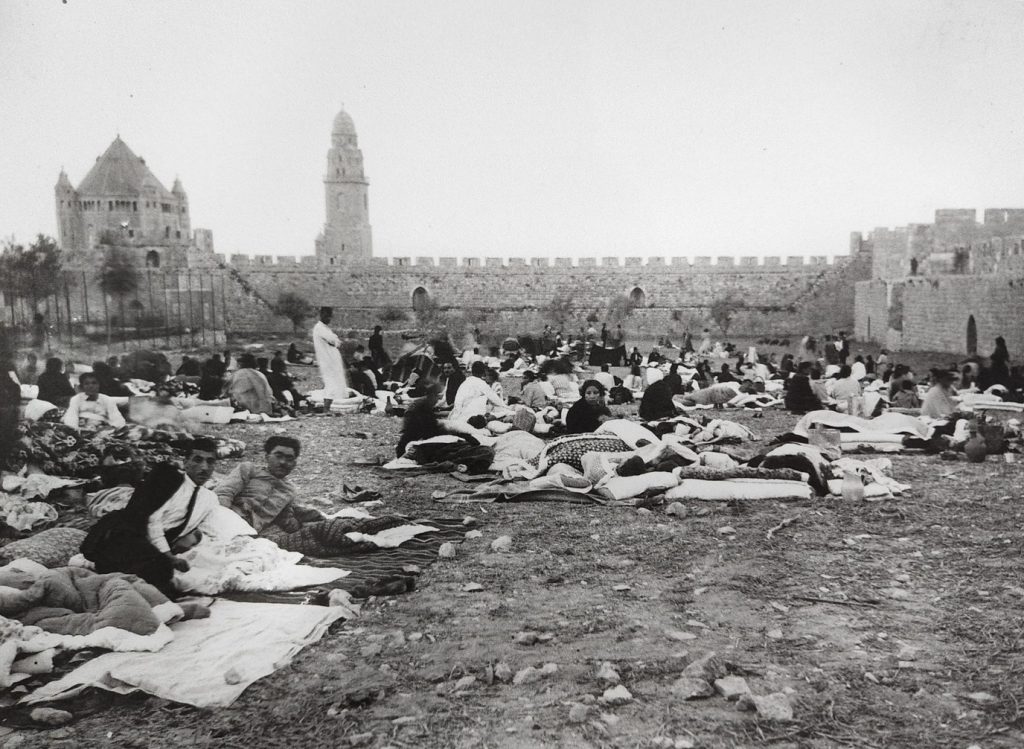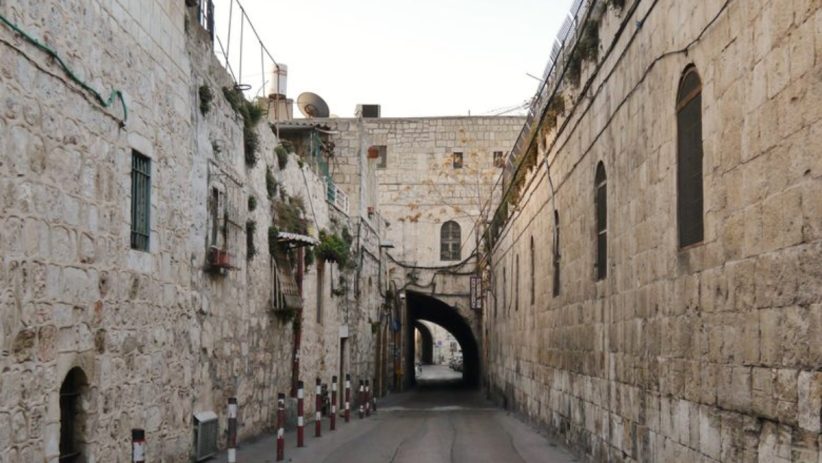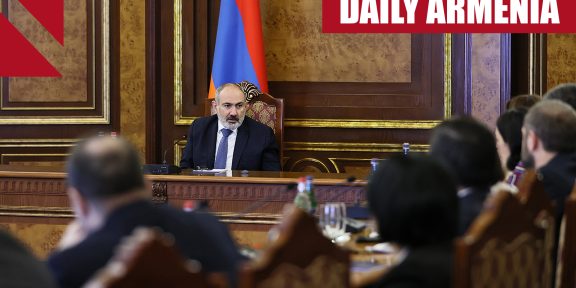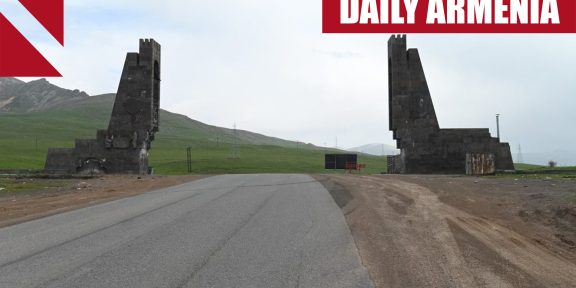By Paul Vartan Sookiasian
The movement to save Jerusalem’s Armenian Quarter had smoldered for years but truly ignited in spring 2023 with the announcement of a secretive land deal. The Armenian Patriarchate consented to lease up to 25% of the quarter’s land to a Australian-Jewish developer who plans to build a luxury hotel on a plot called The Cow’s Garden.
The potential loss of this strategically vital property is considered an existential threat to the local Armenian community, a threat which also resonates far beyond the Armenian world due to the continuing Israeli-Palestinian conflict and the unresolved status of Palestinians in Jerusalem. What started as resistance to the surprise announcement of the lease last April that the Patriarchate grew over the next weeks into the organizing of Save the Armenian Quarter (SaveTheArQ) to lead the movement against the deal.
The movement’s leaders are almost exclusively young people, ones with a great appreciation of the rich history they have been born into and acutely aware of the dangers which imperil its future. As is often the case, the older generations dismissed the organizers as idealist at first, jaded by decades of difficulties and disappointments. Yet as the group began getting results, they appear to have earned the elders’ respect and support. There was also a general hesitancy to go against the Patriarchate which had agreed to the deal, as the livelihoods of many in the Quarter are connected to it. But when in late October the Patriarch announced it was withdrawing from the deal, the situation transformed.
“In the past, relations between local political parties and organizations which make up the community were frozen and sometimes even hostile,” explained Setrag Balian, one of the young leaders of SaveTheArQ. “However the unity we’ve seen since the Patriarchate’s rejection of the deal has been amazing. I see how families come and bring food to the demonstrators. There are people who hadn’t said hello to each other for thirty years who now sit next to each other at the protests. I get tears in my eyes when I see it happening in front of me. It’s what I dreamed of for the community.”
A joint statement issued by all the groups demanding the cancellation of the deal was an unprecedented step, something they had never done before even on issues of broad consensus and significance such as Artsakh.
The Armenians of Jerusalem have a number of affiliations which has afforded them both a richness but also divisive tensions. That this community is centered on one of the most important institutions in the global Armenian Church gives it an additional layer of complexity, as does its geographic location and geopolitical importance.
Like most diaspora communities, Jerusalem is divided between the two main Armenian political parties – the Armenian Revolutionary Federation (Dashnaktsutyun) and the Armenian Democratic League (Ramgavars), each of which has its own affiliated club which is the center of a great deal of life with their youth organization services, scouting programs, sports teams, and cultural programs. A third club is the Parekordzagan, or Jerusalem Armenian Benevolent Union, which is associated with the historic families which have called Jerusalem home for centuries, as opposed to those “newcomers” descended from survivors of the genocide who arrived a hundred years ago. However the pernicious aspects of such divisions have recently faded in the face of this existential threat.
As Balian says “naturally there’s always going to be some issues, things aren’t perfect, but I think Jerusalem has the most unity now of any diaspora community globally.”
Balian’s family has a unique history which isn’t just part of the Armenian Quarter but infused into Jerusalem as a whole. They came from Kutahya in western Turkey, a place where Armenian artisans played a dominant role in the famous tile and ceramic production for which that city was known for centuries. Their tradition was devastated by the genocide, but just a few years later received a new lease on life in Jerusalem.
After World War I, the British set up a mandate in Palestine and sought to revitalize the region’s cultural landscape. They brought the Armenian craftsmen including the Balian family in 1919 to renovate the tiles of the landmark Dome of the Rock. In the hands of these Armenians, the craft developed into its own unique art form which the city is now famous for. The Balians have continued this tradition despite the many tribulations they’ve faced from recurring wars, much in the same way they now struggle to preserve the Patriarchate and Armenian life in Jerusalem.
The family history of the other young leader of the movement, Hagop Djernazian, represents the deep ties between the Armenian Patriarchate and the community’s life. His great-grandparents were orphans of the genocide, one from Marash and the other from Adana, who came to Jerusalem a century ago through Jordan.
As Djernazian explained, their struggle today resonates deeply in their family histories: “Our ancestors who survived the genocide came to Jerusalem looking for shelter, and the Patriarchate gave that to them. The Cow’s Garden land which we fight for now was that first shelter, as before housing was built for the refugees they spent their first months living there in tents. In this way, Jerusalem is kind of a shelter for all Armenians. While many who had come here later left, their families all over the world still have connections to this place.”

The Cow’s Garden was a site of refuge in the 1920s for survivors of the Armenian Genocide
As for Djernazian’s family, his grandfather served as a chauffeur to the Patriarch for 50 years until 1996. “Then my father continued in this role, so as a family we have 70 years of history serving this important institution, and that’s why we’re fighting for its future. When you work for this place it’s not just about making a living, you work for a place that you love, you work for a place that is your home, and you work for a place which is home to all Armenians for more than 1600 years.”
For now, the movement’s leaders occupy the site of the Cow’s Garden, just like their ancestors did a century ago. About ten young demonstrators sleep there every night, while others will come to visit and spend time with them to maintain a presence 24/7 to help guard it.
They have left their homes and families, some even their jobs, in order to dedicate themselves to what has become a full-time struggle.
As Djernazian said “I’m here every day and sleep here every night. Sometimes I need to attend university classes, but in general I spend about 18 of every 24 hours at the encampment.” This hasn’t been without its dangers.
In late December, a mob apparently hired by the developers were sent to attack the demonstrators in a last-ditch effort to displace them before the legal process began. The effort failed. More recently, another assailant allegedly hired by the developers punched Djernazian.
The movement had hoped to cooperate legally in the case over the property as a unified front with the Patriarchate, but that did not prove to be possible, so each one is following separate legal tracks towards the same goal. Though the deal is described as a 99-year lease, due to the complicated nature of land rights steeped in dispossession, once transferred the land is unlikely to ever revert to the Patriarchate as stipulated.
“In the end, this land in question is used by the community and for the future of the community, which is why all groups have united around one cause,” Djernazian explained. “We respect the centuries-old Armenian Patriarchate and are here to protect the institution, not to fight it. A lack of transparency will harm the process.”
Another silver lining of the movement has been a rebuilding of ties with the other Patriarchs and religious communities in Jerusalem through the efforts of SaveTheArmQ, relationships which had been long neglected by the Armenian Patriarchate over the past decades.
Djernazian recounts why this struggle should be important to all Armenians by pointing to an outsized influence often overlooked: “This is a place where we have a quarter out of four quarters, and though Catholics have 1 billion worshippers compared to there being 10 million Armenians at most, we have equal rights with them at the most holy shrines of Christianity.”
Balian sees the movement as an integral part of Armenian identity, and positive boost to it which has been missing in recent years: “Having been in a cycle of defeats and humiliation for the past three years, we hope that a small victory like the one we’ve had so far gives light and hope to the Armenian nation from our spiritual homeland of Jerusalem. It provides a needed demonstration of the power that can come from real unity.”

















5 Comments
as an 88 year old Armenian, whose Parents fled Genozid from Sivas and Gürün, I strongly Support Parekordzagan movement, who seem to Support ARMENIAN needy families and youngsters, without asking IF they are TASHNAG or RAMGAVAR ! It is time that Armenians Group up as ARMENIANS TODAY, dismissing OLD movements that did NOT achtete Armenian Unity in the 21st Center, even after WE LOST Karabagh to the Azeri.
Where is this stuborn “divisionism” going to carry us ? We should LOOK at the Arab World and Palestine TODAY & learn what & where such egoistic patries/countries have brought the Palestinian perplex vs. a small, but more United Israel.
A pennen for your thoughts !
Hratch Boyadjian
as an 88 year old Armenian, whose Patents fled Genozid from Sivas and Gürün, I strongly Support Parekordzagan movement, who seem to Support ARMENIAN needy families and youngsters, without asking IF they are TASHNAG or RAMGAVAR ! It is time that Armenians Group up as ARMENIANS TODAY, dismissing OLD movements that did NOT achtete Armenian Unity in the 21st Center, even after WE LOST Karabagh to the Azeri.
Where is this stuborn “divisionism” going to carry us ? We should LOOK at the Arab World and Palestine TODAY & learn what & where such egoistic patries/countries have brought the Palestinian perplex vs. a small, but more United Israel.
A pennen for your thoughts !
Hratch Boyadjian
I believe it is time for the Patriaracrt to resign
and ALL the folks who were involved in
this deed
Great report about the challenges created by the Israeli government through extremist elements of its society.
It is also a great recount of the united front of the world Armenians alongside the local Armenian community and patriarchate.
The dedication of the East Jerusalem Armenian community, and the young, protecting the historic rights of the Armenians in Palestine to exist/survive/thrive is commendable and unparalleled.. More power.
Proud of the young and defiant generation, led by Hagop and Setrag.